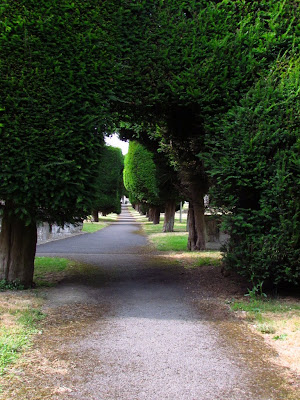Today we went to Berkeley Castle, the ancient fortress home where the Berkeley's have lived since their ancestor, Robert Fitzharding, completed the Keep in the late 12th Century. Berkeley Castle is one of the most remarkable buildings in Britain and possibly the most outstanding example of Mediaeval domestic architecture in the country. Where other Castles were romanticised or "modernised" by the Georgians or the Victorians, Berkeley quietly survived as what it is: a Norman fortress with an enclosing curtain wall, built and enlarged through the mediaeval period and beyond into a secure, comfortable, substantial home.
 |
| We started by going to the Butterfly House |
 |
| The Stables and Kennels |
 |
| The Gossips who it was believed would turn into Toads for gossiping |
 |
| Old time humour a fly in the sundial - time flies |
 |
| The cellars - 200 gallons of beer in each keg! |
Behind the castle is St Mary's Church with a very unusual tomb to a jester. It says Here lies the Earl of Suffolk's foul, men called him Dicky, his folly served to make folks laugh, when wit and mirth were scarce, poor Dick alas is dead and gone.


We then drove to Tetbury in the Cotswolds, proud of its 1300 years of recorded history since 681 when Tetta's Monastery was mentioned in a charter by King Ethelred of Mercia. In the Middle Ages, Tetbury was an important market town for the Cotswolds wool trade and the town centre is still dominated by the splendid pillared Market House built in 1655. The town is known as an 'architectural gem' as many of the wool merchants houses still look as they did 300 years ago. Tetbury is well known for close proximity to Prince Charles's residence of High Grove. The town has a wonderful variety of shops including many specialist shops offering a wide choice. Many of the shops are individually owned where you will receive personal attention of the owner and experience a level of service long since vanished from many high streets. Several of Tetbury's retailers have received national awards for excellence and the visitor will notice that many of the towns businesses bear the Prince of Wales feathers as a sign that they hold the Royal Warrant. The Parish Church of St. Mary The Virgin was built by Francis Hiorn between 1777 and 1781. The church has been described as 'one of the best Georgian Gothic designs'. The church spire is the fourth highest in England.
 |
| St Mary the Virgin and St Mary Magdalen Church - medieval tower was completely rebuilt in 1891 and houses a ring of 8 bells, the spire is 186ft or 57mtr. |
 |
| The high box pews made in dark oak can seat 400 people and were rented to the families the boxes are so high only the heads would be visible when sitting |
 |
| The gallery above the boxed pews is very unusual the brass chandeliers made in London in 1781 where the candles are still lit for Christmas and special occasions. |
 |
| Market House |
 |
| The feathers of Prince Charles identifying the business as providing the Royal Household with their cheese products |
 |
| View of the villages in the Cotswalds |


Our next stop was Painswick nestled quietly in the famous Cotswold hills, surrounded by some of Gloucestershire's most delightful countryside is this historic wool town. Built of mellow Cotswold stone from the local quarry on Painswick Beacon the town's many beautiful buildings can be seen as you wander around its quaint and narrow streets. New Street, constructed around 1428 when the wool and cloth trade was flourishing, contains the oldest building in England to hold a Post Office, Painswick's only example of exposed timber framing. Beacon House with its magnificent Georgian Frontage. There are rare 17th century spectacle stocks near the court house. 14th century houses in Bisley Street include two original Donkey doors, Wide enough for panniered donkeys who carried the wool from the numerous mills along the local valleys. The church of St Mary (originally Norman) was extended around 1480 in the English perpendicular style. The churchyard with 99 yew trees (legend has it that the 100th won't grow) and unusual tabletop tombs. A closer look at the church tower still reveals traces of Painswick's role in the Civil War. Today there is a variety of small shops and galleries to browse around with pubs, restaurants and tea shops that serve good food. Painswick is a Fair Trade town
.
 |
| Painswick only timber framed building |
 |
| St Mary's church and Yew Trees |
 |
| The Donkey Doors |










































No comments:
Post a Comment